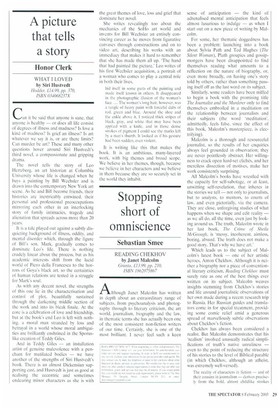A picture that tells a story
Honor Clerk
WHAT I LOVED by Sid Hustvedt Hodder. £14.99, pp. 370, ISBN 034068237X Can it be said that anyone is sane, that anyone is healthy — or does all life consist of degrees of illness and madness? Is love a kind of madness? Is grief an illness? Is art whatever we say it is, or are there limits? Can murder be art? These and many other questions hover around Sin i HustvecIt's third novel, a compassionate and gripping drama.
The novel tells the story of Leo Hertzberg, an art historian at Columbia University whose life is changed when he buys a painting by Bill Wechsler and is drawn into the contemporary New York art scene. As he and Bill become friends, their histories are inextricably entwined, their personal and professional preoccupations mirroring each other in an interlocking story of family intimacies, tragedy and alienation that spreads across more than 20 yea rS.
IT is a tale played out against a subtly disquieting background of illness, oddity, and mental disorder which, through the figure of Bill's son, Mark, gradually comes to dominate Leo's life. There is nothing crudely linear about the process, but as his academic interests shift from the lucid world of Piero della Francesca to the horrors of Goya's black art, so the certainties of human relations are tested in a struggle for Mark's soul.
As with any decent novel, the strengths of this one lie in the characterisation and control of plot, beautifully sustained through the darkening middle section of the work and into its bleak finale. At the core is a celebration of love and friendship, but at the book's end Leo is left with nothing, a moral man stranded by loss and betrayal in a world whose moral ambiguities are brilliantly enshrined in the Sporuslike creation of Teddy Giles.
And in Teddy Giles — an installation artist of genuine malevolence with a pen chant for mutilated bodies we have another of the strengths of Sin i Hustvedt's book. There is an almost Dickensian supporting cast, and Hustvedt is just as good at realising the eccentric and sometimes endearing minor characters as she is with the great themes of love, loss and grief that dominate her novel.
She writes revealingly too about the mechanics of the SoHo art world and invents for Bill Wechsler an entirely convincing career as he moves from figurative canvases through constructions and on to video art, describing his works with an immediacy that makes it hard to remember that she has made them all up. 'The hand that had painted the picture,' Leo writes of his first Wechsler acquisition, a portrait of a woman who comes to play a central role in both their lives, hid itself in some parts of the painting and made itself known in others. It disappeared in the photographic illusion of the woman's face .... The woman's long hair, however, was a tangle of heavy paint with forceful dabs of red, green and blue. Around the shoe and the ankle above it. I noticed thick stripes of black, aray, and white that may have been applied with a knife, and in those dense strokes of pigment I could see the marks left by a man's thumb. It looked as if his vesture had been sudden, even violent.
It is writing like this that makes the book. It is an ambitious, many-layered work, with big themes and broad scope. We believe in her themes, though, because we believe in her characters and we believe in them because they are so securely set in the world they inhabit.


























































 Previous page
Previous page